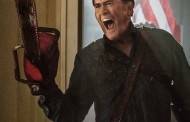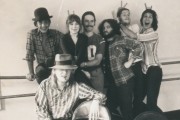Raising Renee (review here) is a fantastic documentary that premiered on HBO last week. Check here to find the next showing or watch it On Demand.
Acclaimed directing team Steven Ascher and Jeanne Jordan answered a few questions for MovieBuzzers about the film.
MB: Where did the idea for the film come from? How did you find Beverly?
Jeanne Jordan and Beverly when they both received Radcliffe Institute for Advanced Studies fellowships at Harvard. It was a yearlong fellowship and Jeanne was editing their last film So Much So Fast and Beverly was doing a series of paintings. They had adjacent studios and a friendship developed. Beverly told Jeanne about her life, her family and the origins of her wonderful paintings with her characteristic frankness and humor. She told Jeanne about the promise she had made years earlier to her mother Ethel to care for her older sister Renee, who is intellectually disabled, if her mother should die. The combination of Beverly’s storytelling ability, her openness and her humor along with the stunning visual of her painting made her a natural film subject.
MB: It seems the story evolved, what was the original intent when you started?
As often happens when documentaries are started Jeanne and Steve began filming not knowing where it would go or even if it would go. The first shoot was Beverly’s first solo opening in NYC which her mother and sister Renee attended. Ethel was in great health and it was an exciting time for the family. Four months later Ethel was diagnosed with pancreatic cancer. She died three months later. Everything changed as the promise had now come due.
MB: Beverly and her family are very open about their feelings. Is this something that was right from the start or gradual?
Well, I’d say the McIver girls Renee, Roni and Beverly are all naturally open and very funny people. Of course it took time (and we had a lot of it what with filming for six years and all…) for us to reach the place of complete comfort that we felt by the end but they were always generous and clearly trusted us from the beginning.
MB: How is your work dynamic as co-directors?
We’ve developed it over more than twenty years and it’s pretty seamless most of the time. We both decide what and when to film and take equal share in directing, making arrangements etc. But a lot of the time we tend to divide and conquer—Steve is the cinematographer and I’m the editor. That doesn’t mean we don’t give each other lots of input but we try to work separately at times so the other remains a pair of “fresh eyes”—there’s a way when you’re too close to material you can’t see it anymore. We write together—once again tending to have one do a pass and then the other. I’d say the most important quality needed in a husband and wife doing something like this together is compartmentalization. When you’ve got your filmmaker hats on that’s good. When you take them off you’re back in regular life.
MB: What were some moments of fortune or obstacles that came along?
It’s hard to keep track of the obstacles when making a documentary film because there are so many and you try to forget them as you soldier on—so let’s talk about the fortune: We thought we were done in fall 2009 when Beverly called and said Renee wanted to try living on her own in a housing development for the disabled. Bev wasn’t sure if we’d want to film but of course we did and it changed the film completely. It also delayed finishing because we weren’t comfortable releasing the film until we knew for sure that Renee’s new situation was going to ‘take” so we waited almost a year just to make sure. It would not have been good to send the film out there and then say “Oops! She moved back in with Beverly a month later!” But waiting was the right thing to do. Renee loves her new place, her cat Snowball and when her lease came up Bev asked if she wanted to live together again and Renee said “I know you want me to but I really like it here!” That’s what you call a happy ending.
MB: What is your favorite moment of filming?
Right after Beverly has buried her longtime companion cat Taylor and she’s sitting on the couch with her other cat Callie, trying to take in all of the changes in her life. It is one of the most poignant instances of human/animal understanding I’ve ever seen on film. And beautifully shot—thanks to Steve!
MB: How long was the editing process?
Too long. Just kidding—we did a lot of other projects over the six years so I’d say the process took about a year and a half all told.
MB: How are Beverly and Renee doing now?
They are great. The film and traveling with it has been a wonderful and fun experience for us all. Beverly is painting like mad and applying for fellowships. Renee is selling potholders at an amazing clip—they’ve been extremely popular on the film festival circuit—but I should warn folks that the price has gone up. In 2003 they were going for $1.25 a piece. Now, in 2012 they’re $8. Cost of living increase.

















Recent Comments